Each succulent stands out in its own way — the variegated foliage of Aeonium, the size and grandeur of agave, the cold-hardiness and resilience of
Sempervivum. Out-of-this-world color and year-round beauty belong to
Echeveria.
Hailing from semidesert regions of Mexico and of Central and South America,
Echeveria thrives in the mild climates of California and the American Southwest. Its colorful, glaucous foliage and year-after-year flowering makes it one of the most popular succulent types. Cold sensitivity may be a concern for many gardeners, but conveniently enough, Echeveria makes a great container plant. Once fall rolls in, just pack up and bring it indoors. Welcome your containers back into the garden in spring.
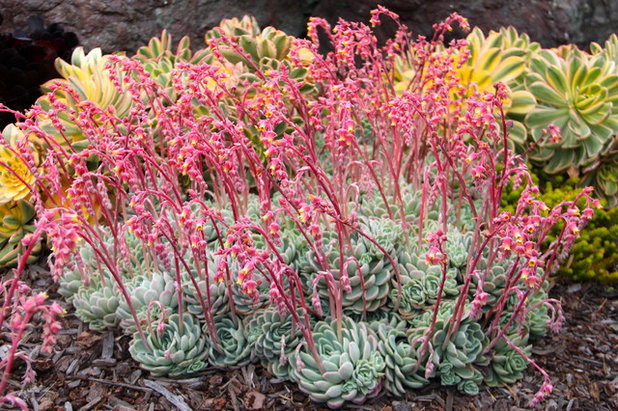
Gardens by Gabriel, Inc.
Botanical name: Echeveria spp
Common names: Echeveria, hens-and-chicks
Where it will grow: Hardy to around 32 degrees Fahrenheit (USDA zones 8 to 11; find your zone)
Water requirement: Looks best with moderate water
Light requirement: Full sun, but shelter it from harsh summer sun
Mature size: Varies with species
Benefits and tolerances: Drought tolerant; deer resistant
Seasonal interest: Evergreen; flowers in summer
When to plant: Plant cuttings or offsets spring through fall; allow the stem end to become callous.
Shown: Echeveria elegans in bloom backed by
Aeonium 'Sunburst'
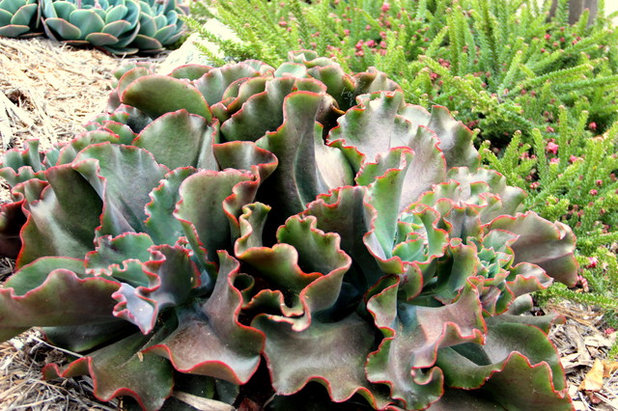 Shown: Echeveria
Shown: Echeveria 'Zorro'
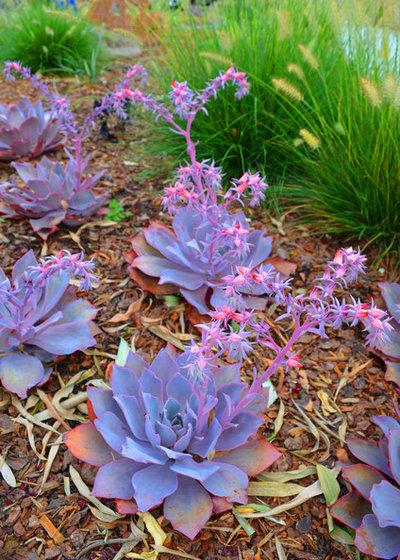
Bloom Garden Design
Distinguishing traits. Echeveria is rosette forming, with fleshy green leaves in colors ranging from green to gray-green to purple, with colored tips and other quirky accents augmenting its playful demeanor. The color remains strong year-round, and even in the dark grays of winter, your garden will receive a nice pink foliage pick-me-up.
Unlike many succulents, Echeverias are not monocarpic and can flower several times throughout a lifetime. In summer look for a stem of clustered flowers, often in bright pinks and yellows.
Shown: Echeveria 'Afterglow'
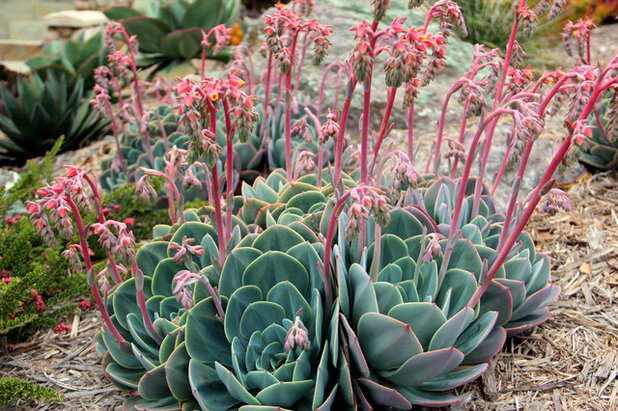 Shown: Echeveria
Shown: Echeveria 'Imbricata'
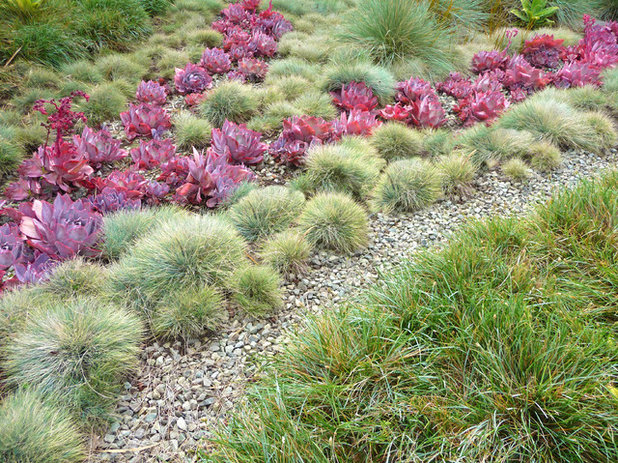
Kiesel Design - Landscape Architecture
How to use it. Plant Echeveria en masse, as a container specimen or along a rocky bank. Depending on your climate zone and style preference, the options are pretty open. Landscape architect Jack Kiesel uses
E. ‘Afterglow’ as a garden statement piece. He notes its tolerance of partial shade and ability to brighten darker garden patches as winning traits. He likes to use Echeverias with other succulents, as well as with contrasting grasses. Kiesel suggests you avoid planting Echeverias where there will be heavy foot traffic, as this will damage the plants.
Echeveria 'Afterglow' is shown here planted in broad swaths with Elijah blue fescue (
Festuca ‘Elijah Blue’), blue moor grass (
Sesleria caerulea) and blue oat grass (
Helictotrichon sempervirens), with a mix of blue foxtail agave (
Agave attenuata ‘Nova’) and orange Libertia (
Libertia peregrinans).
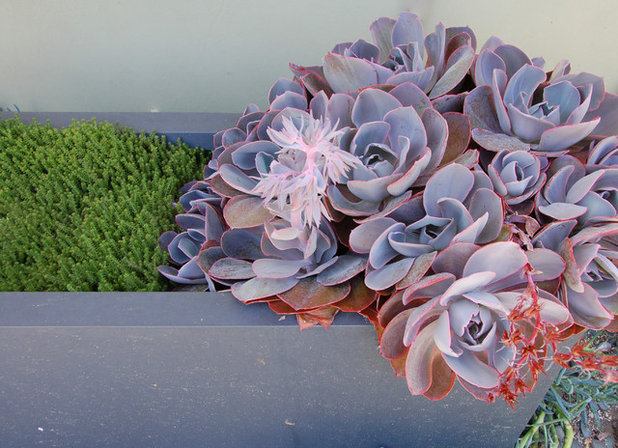
Joni L. Janecki & Associates, Inc.
Shown: Echeveria 'Afterglow'
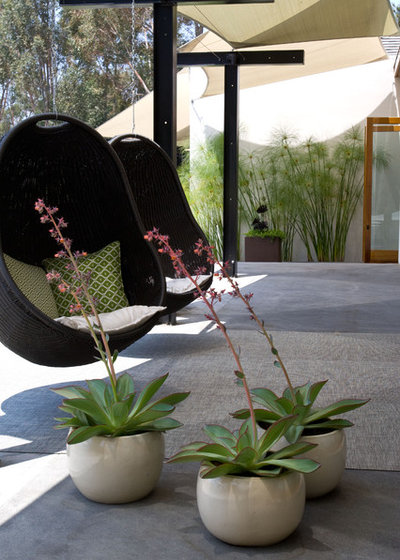
Grounded - Richard Risner RLA, ASLA
Echeverias are commonly planted in containers. Their portability makes summer and winter maintenance that much easier.
If summer climates are more extreme, shelter plants from direct sunlight. Likewise, bring your Echeveria indoors if your climate experiences freezing winters. Be sure to provide ample direct light.
Shown: Echeveria subrigida ‘Fire and Ice’
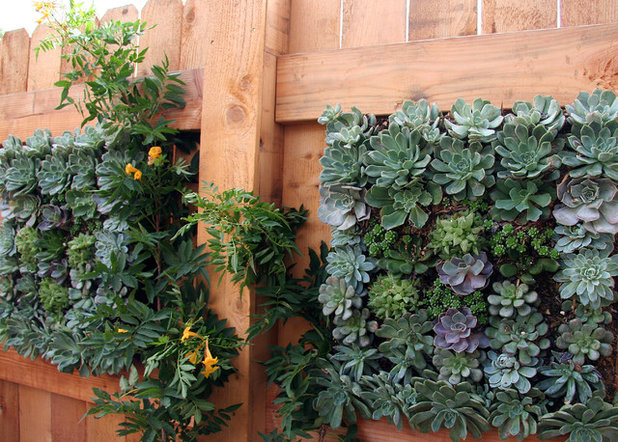
Donna Lynn - Landscape Designer
Echeverias are also used in living walls for sunny locations.
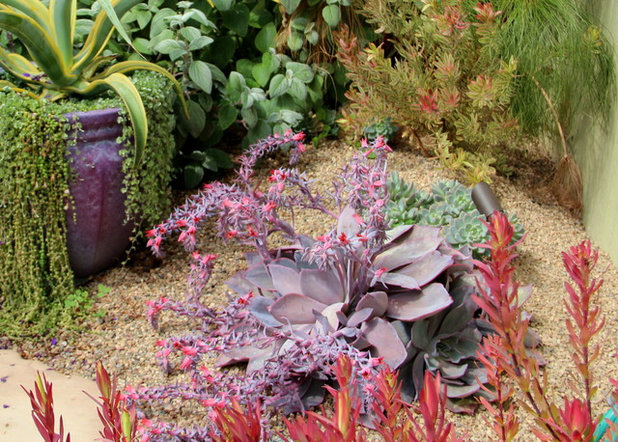
Gardens by Gabriel, Inc.
Shown: Echeveria ‘Afterglow'
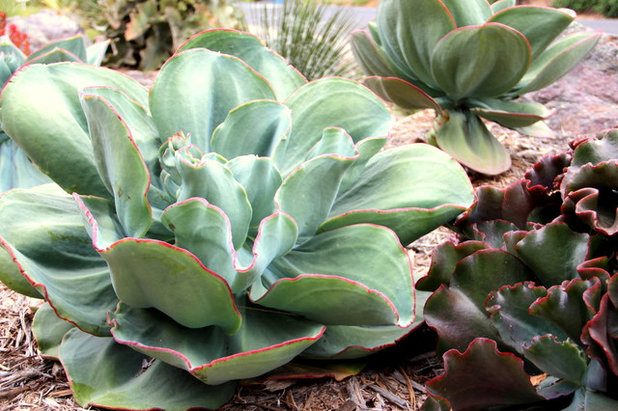 Planting notes.
Planting notes. Landscape designer Gabriel Frank says Echeverias look healthiest and develop the best year-round color when planted in full, coastal sun. "As it gets hotter, even 4 to 5 miles inland, they lose that signature jewel-tone glaucous covering that makes their leaves so ethereal," Frank says.
Some Echeverias develop tall stalks, and eventually you may want to cut and reroot the rosette, much like is done with Aeonium. Leave the stalk and new Echeverias will sprout. Others produce offsets, which can also be used to propagate.
Try to avoid extreme light and temperature swings while providing good air circulation and good light. Give it some water but not too much, and otherwise let it do its thing.
Shown: E. gigantea and
E. 'Zorro'
Great Design Plants: More beautiful succulents for the garden





